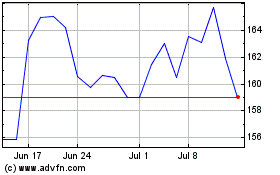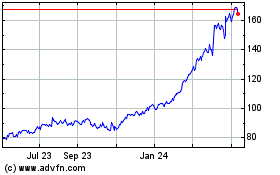By Tatyana Shumsky and Ezequiel Minaya
General Electric Co.'s bet on selling long-term care insurance
policies, which ballooned into a $16.5 billion liability,
underscores how policies meant to pay for nursing homes and
prescription costs have become one of the most unpredictable
segments of the insurance industry.
GE's skyrocketing liability is but only one example of an
industrywide lapse in judgment when assessing the future cost of
such care, industry experts said. Prudential Financial Inc., which
stopped issuing long-term care insurance in 2012, recorded a $1.5
billion charge related to its portfolio in the second quarter.
Genworth Financial Inc., which is among the roughly dozen companies
still offering this type of insurance, has incurred more than $3
billion in losses stemming from these plans.
GE in January reported a $6.2 billion charge linked to
liabilities for long-term care insurance policies, which prompted
federal regulators to expand a probe into the company's accounting
practices. The company has said it is cooperating with
investigators.
The Wall Street Journal reported Friday that former GE employees
told federal investigators that the company failed to acknowledge
worsening results in the insurance business.
GE also faces shareholder lawsuits alleging that it understated
risks related to its insurance operations.
"We are exploring every option to manage and mitigate risk from
the company's legacy insurance liabilities," said a GE spokeswoman,
who declined to comment on specifics of ongoing legal matters. "We
have a strong commitment to integrity in our controllership and
financial reporting."
Insurers make the bulk of their money from the premiums charged
to policyholders and from investing those premiums before paying
out claims. Forecasting the future payout for long-term-care
policies can prove particularly difficult.
That calculation involves census data, actuarial science and
mortality rates, among other mercurial variables. But it also
requires guesswork around the future price of health care.
"Assisted living, health care and prescriptions -- the inflation
rate in those things is massive," said Peter Bible, a partner and
chief risk officer at accounting firm EisnerAmper LLP.
Muddying the math is the unpredictable nature of regulation,
which could affect the portion of costs shouldered by the
government. "It's very complicated science," said Mr. Bible, a
former chief accounting officer at General Motors Co.
In recent decades, many long-term care plan providers
underestimated the payouts they would face when plans came due and
didn't charge high enough premiums. Companies also misjudged how
long claims would be paid out as consumers lived longer.
Moreover, the low interest-rate environment during the past
decade has dented the investment returns of insurance
companies.
"Who could have predicted interest rates would have been this
low for this long," said Jesse Slome, executive director of the
American Association for Long-Term-Care Insurance.
The dozen companies that offer a long-term care product include
Northwestern Mutual, Mutual of Omaha and Transamerica Corp.,
according to Mr. Slome, down from about 75 in the 1980s, when
long-term-care insurance became popular.
Insurance companies have recorded more than $28 billion in
charges related to long-term care insurance policies since 2007,
according to estimates by analysts at investment bank Evercore
ISI.
Changes in GE's risk assessment and assumptions triggered a $6.2
billion charge related to the insurance portfolio, the company
explained in a January conference call. At the time, GE estimated
it will need to contribute roughly $15 billion to its insurance
business over the next seven years.
GE stopped selling long-term care policies in 2006, but the
company hadn't reassessed the assumptions behind the likely risks
of these plans until 2017, said Ryan Zanin, GE Capital's chief risk
officer at the time, during the call.
GE Capital is the company's financial services unit. Mr. Zanin
left GE in June to pursue opportunities outside the company, a GE
spokeswoman said.
GE performed an annual test to ensure future premiums and
reserves would cover future claims, as required by regulators.
Because the company cleared the hurdle in previous years, it had to
leave in place existing risk assumptions, Mr. Zanin said on the
call.
That changed in 2017, however, when a surge in claims by one
segment of GE's insurance portfolio triggered a review. The
policyholders in that block were approaching 80 years or older,
when the bulk of claims tend to arise, Mr. Zanin said.
"Virtually, the entire industry has experienced greater claims
than originally anticipated where more people go on claim and for
longer than expected," he said on the call.
Prudential's charge, reported in August, followed a similar
annual review of the profitability of its remaining long-term care
portfolio. A Prudential spokesman declined to comment.
Genworth Financial, which was spun off from GE in 2006, has
incurred a cumulative statutory net loss of over $3 billion as of
Sept. 30, stemming from its legacy long-term care insurance
business.
Genworth continues to lose hundreds of millions on these legacy
blocks each year, a company spokeswoman said.
The company evaluates its assumptions annually and has taken a
proactive approach to premium increases, achieving approximately
$10 billion in approved rate increases on some of its newer
products, the spokeswoman said. The company is also working with
regulators to adopt a system of re-rating long-term care premiums
annually, in a way that is similar to how insurers adjust premiums
on homeowners, auto and health insurance, the spokeswoman said.
GE is seeking ways to mitigate its exposure to long-term care
insurance, the company's executives have since said.
GE was expected to perform in the fourth quarter the annual
reserves-adequacy test, the inputs for which were reset last year.
In advance of that, GE management anticipated an additional capital
infusion of $3 billion into the insurance business in 2019, GE
finance chief Jamie Miller said on an earnings call in October.
Write to Tatyana Shumsky at tatyana.shumsky@wsj.com and Ezequiel
Minaya at ezequiel.minaya@wsj.com
(END) Dow Jones Newswires
December 03, 2018 14:01 ET (19:01 GMT)
Copyright (c) 2018 Dow Jones & Company, Inc.
GE Aerospace (NYSE:GE)
Historical Stock Chart
From Mar 2024 to Apr 2024

GE Aerospace (NYSE:GE)
Historical Stock Chart
From Apr 2023 to Apr 2024
